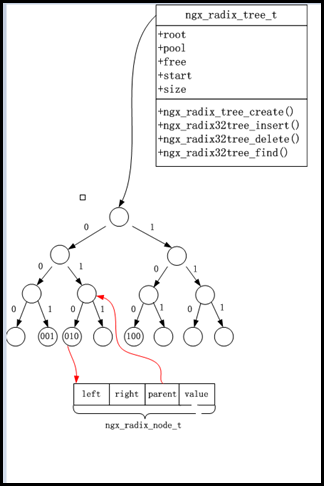radix专题
循环队列的实现及应用——桶排序bucket_sort、基数排序radix_sort
一、循环队列的实现 代码解释 1、完成初始化 2、定义方法 3、测试实例 4、完整代码 class AQueue:def __init__(self, size=10):self.__mSize = sizeself.__front=0self.__rear = 0self.__listArray = [None] * size#清空元素def clear(self):se
菜鸟nginx源码剖析数据结构篇(五) 基数树 ngx_radix_tree_t
分类: Server - 菜鸟nginx源码剖析 2014-10-28 17:20 8388人阅读 评论(3) 收藏 举报 基数树 nginx 剖析 源码 radix_tree 目录(?)[+] 菜鸟nginx源码剖析数据结构篇(五) 基数树 ngx_radix_tree_t Author:Echo Chen(陈斌) Email:ch
算法 - 基数排序(Radix Sort)
基数排序非常适合用于整数排序(尤其是非负整数),因此只演示对非负整数进行基数排序执行流程:一次对个位数、十位数、百位数、千位数、万位数…进行排序(从低位到高位) 个位数、十位数、百位数的取值范围都是固定的0~9,可以使用计数排序对它们进行排序思考:如果先对高位排序,再对低位排序,是否可行?不行 实现 int max = array[0]; // 最大值for (int i = 1; i <
数据结构之Radix和Trie
数据结构可视化演示链接,也就是视频中的网址 Radix树:压缩后的Trie树 Radix叫做基数树(压缩树),就是有相同前缀的字符串,其前缀可以作为一个公共的父节点。同时在具体存储上,Radix树的处理是以bit(或二进制数字)来读取的。一次被对比r个bit。 Radix树演示 Trie树 即字典树,也有的称为前缀树,是一种树形结构。广泛应用于统计和排序大量的字符串(但不
Intro-to-algo (counting sort, radix sort, decis...
2019独角兽企业重金招聘Python工程师标准>>> ======================================== Lecture 5 How fast can we sort? comparison sorts e.g. quicksort, insertion sort, merge sort, heapsort No comparison sor
3.3.17内核基数树radix_tree源码解析与示例分析
文章目录 基数树定义结构体slotstags 接口初始化静态动态系统 插入删除查找 示例示例1示例2 参考 基数树 Linux基数树(radix tree)是将long整数键值与指针相关联的机制,它存储有效率,并且可快速查询,用于整数值与指针的映射,在内核代码中,使用基数树最多的场景是:IDR机制和内存管理等。 定义 结构体
3.3.17内核基数树radix_tree源码解析与示例分析
文章目录 基数树定义结构体slotstags 接口初始化静态动态系统 插入删除查找 示例示例1示例2 参考 基数树 Linux基数树(radix tree)是将long整数键值与指针相关联的机制,它存储有效率,并且可快速查询,用于整数值与指针的映射,在内核代码中,使用基数树最多的场景是:IDR机制和内存管理等。 定义 结构体
如何在 Go 语言中使用 Redis 连接池-Radix.v2
一、关于连接池 一个数据库服务器只拥有有限的资源,并且如果你没有充分使用这些资源,你可以通过使用更多的连接来提高吞吐量。一旦所有的资源都在使用,那么你就不能通过增加更多的连接来提高吞吐量。事实上,吞吐量在连接负载较大时就开始下降了。通常可以通过限制与可用的资源相匹配的数据库连接的数量来提高延迟和吞吐量。 如果不使用连接池,那么,每次传输数据,我们都需要进行创建连接,收发数据
PAT 1010 Radix (25)
1010 Radix (25)(25 分) Given a pair of positive integers, for example, 6 and 110, can this equation 6 = 110 be true? The answer is yes, if 6 is a decimal number and 110 is a binary number. Now for an
C++标准模板(STL)- 类型支持 (数值极限,max_digits10,radix,min_exponent)
数值极限 定义于头文件 <limits> 定义于头文件 <limits> template< class T > class numeric_limits; numeric_limits 类模板提供查询各种算术类型属性的标准化方式(例如 int 类型的最大可能值是 std::numeric_limits<int>::max() )。 区别所有此类型值所需的十进制位数 std:






